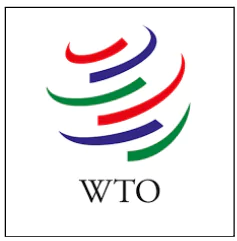The World Trade Organization (WTO) was established to oversee international trade rules, resolve disputes, and facilitate negotiations.

- However, in recent years, its effectiveness has come under severe scrutiny due to its inability to perform its core functions effectively, particularly negotiation, dispute resolution, and trade monitoring.
India and WTO
- Founding Member: India has actively participated in WTO negotiations since its inception, promoting inclusive trade that supports development goals.
13th Ministerial Conference (MC13) of the WTO
- WTO Ministerial Conference (MC) is the highest decision-making body, held biennially, where all WTO members discuss and decide on global trade matters.
- MC13 was held in Abu Dhabi in February 2024, with participation from all WTO members, focusing on trade reforms and emerging global challenges.
- It ended in a deadlock in the WTO negotiations on a public stock-holding programme.
- India opposed the inclusion of non-trade issues such as gender and MSMEs in WTO discussions, emphasizing the risk of trade fragmentation.
- India also raised concerns over unilateral trade protectionism under environmental pretexts, urging the WTO to uphold fair and rules-based trade practices.
|
- WTO Support for India
- Victory in Steel Dispute: In 2016, WTO ruled in India’s favor against the U.S. for imposing anti-dumping duties on Indian steel exports.
- Solar Panel Case Partial Relief: Although initially ruled against India in the solar case, the WTO upheld India’s right to promote renewable energy with certain modifications.
- Areas of Contention for India
- Agricultural Subsidies: India opposes the WTO’s 10% subsidy cap, citing the need for food security through Minimum Support Price (MSP).
- Public Stockholding: India resisted agreements that could limit its grain procurement programme for food security, especially at MC13.
- Leadership in G33 and G77: India represents developing economies in negotiations, advocating for policy space and equitable trade norms.
- G33 is a coalition of developing countries at the WTO which advocates for special safeguards and public stockholding rights to protect small farmers and ensure food security.
- G77 aligns with WTO negotiations to represent the collective economic interests of developing nations and push for equitable global trade rules.
Appellate Body of the WTO
- Establishment and Purpose: The Appellate Body was established in 1995 under the Dispute Settlement Understanding (DSU) of the WTO to hear appeals on legal interpretations from panel reports.
- Composition and Membership: It consists of seven members, appointed by consensus of WTO members for a four-year term, renewable once.
- Members are experts in law and international trade.
- Jurisdiction and Function: The Appellate Body only hears appeals related to legal questions arising from WTO panel rulings; it cannot re-examine factual findings.
- Binding Decisions: Its rulings must be adopted by the Dispute Settlement Body unless all WTO members agree to reject them, making its decisions effectively binding.
- Current Dysfunction: Since 2019, the body has been non-functional due to the U.S. blocking appointments, creating a backlog and paralyzing the WTO’s dispute resolution system.
|
- Reform Suggestions by India
-
- Consensus Flexibility: India supports reforming WTO decision-making while maintaining consensus on sensitive issues like agriculture and intellectual property rights.
- Proponent of Special and Differential Treatment (S&DT): India consistently advocates S&DT for developing countries to ensure fair trade opportunities, especially in agriculture.
- Restoring DSM: India has called for immediate revival of the Appellate Body to restore credibility in dispute resolution.
What is a Trade War?
- A trade war occurs when countries impose tariffs or other trade barriers on each other in retaliation, often escalating tensions and disrupting global supply chains.
- For example the recent Tariff war between the U.S and China is a type of trade war.
- Wider Impact: The U.S.-China tariff war, initiated in 2018, saw both nations imposing tariffs worth hundreds of billions of dollars on each other’s goods.
- This conflict disrupted global markets, increased production costs, and contributed to global economic uncertainty.
WTO Mechanisms to Deal with Trade Wars
- Dispute Settlement Mechanism (DSM): The WTO provides a structured process for resolving disputes. In 2019, China filed a complaint against U.S. tariffs under Section 301, and a WTO panel ruled them inconsistent with WTO rules.
- Appellate Review: Normally, both parties can appeal panel decisions. However, since 2019, the Appellate Body has been non-functional, delaying final resolutions.
- Consultation and Monitoring: WTO encourages initial consultations before escalation.
- However, delayed monitoring of Chinese export restrictions shows its limited effectiveness in urgent trade conflicts.
- Trade Policy Review Mechanism (TPRM): It offers transparency and accountability but lacks enforcement power to stop ongoing trade wars.
Achievements and Successes of WTO
- Establishment of Core Trade Principles: The WTO has upheld foundational norms like the Most-Favoured-Nation (MFN) and National Treatment principles, ensuring non-discriminatory trade practices.
-
- These rules have fostered predictability and fairness in global trade relations.
- Effective Dispute Settlement System: The Dispute Settlement Mechanism (DSM) has resolved over 600 cases since 1995, including high-profile disputes like EU vs. U.S. on aircraft subsidies
- Its legal structure brought stability and trust among member states until recent deadlocks.
- Market Liberalisation through GATT and WTO Rounds: Through successive negotiation rounds under GATT and the WTO, average global tariffs significantly decreased.
- The Uruguay Round (1986–94), for instance, led to the creation of the WTO and broader commitments in agriculture and services.
- Trade Facilitation Agreement (TFA): Signed in 2013, the TFA aimed at reducing red tape in customs procedures.
- According to WTO estimates, it could reduce global trade costs by up to 14%, especially benefiting small and medium economies.
- Agreement on Information Technology (ITA): The 1996 ITA eliminated tariffs on numerous tech products.
- Its expansion in 2015 covered over $1.3 trillion in annual trade, boosting the digital economy and global ICT access.
Recent events highlighting failure of WTO:
- Deadlock at the 13th Ministerial Conference (MC13): The stalemate between developed and developing countries, especially concerning agricultural subsidies, highlighted deep-rooted disagreements and underscored the WTO’s ongoing governance crisis.
- The conference without consensus on critical issues such as the public stockholding (PSH) programme.
- Return of Protectionist Measures: The resurgence of protectionism, including the imposition of tariffs by major economies like the United States under policies such as ‘reciprocal tariffs’, signals a reversal from the liberal trade order.
- These actions undermine the multilateral trading system envisioned by the GATT, the WTO’s predecessor.
Challenges and Criticisms of WTO
- Failure of the Doha Round and Negotiation Stalemate: The Doha Development Round, launched in 2001, aimed to address the needs of developing countries but has failed to reach a meaningful conclusion.
- Disagreements over agricultural subsidies, market access, and special and differential treatment led to negotiation fatigue.
- The dysfunction of the Dispute Settlement System: The Appellate Body which is the apex institution for trade dispute resolution has become non-functional due to the United States blocking the appointment of judges.
- This has weakened the enforceability of WTO rulings and left a legal vacuum in international trade adjudication.
- Lack of Transparency and Trade Monitoring Deficits: Several WTO members have failed to report their trade measures transparently, making the organization’s trade monitoring function ineffective.
- This lack of compliance hampers timely assessments and creates an uneven playing field.
- For Example delayed WTO monitoring of China’s export restrictions on critical minerals like gallium and germanium.
- Dominance of Bilateral and Regional Trade Agreements: With multilateral negotiations at a standstill, many countries have turned to bilateral and regional trade agreements, bypassing the WTO framework.
- These deals often undermine the MFN principle and fragment the global trade regime.
- China’s Trade Practices and Structural Limitations: The WTO has struggled to manage the rise of China as a dominant exporter.
- Its rules were not designed to address practices such as excess production capacity and state subsidies, which, while not always violating WTO rules, distort trade and challenge the system’s integrity.
Reason of Deteriorating Relevance Of WTO in a Changing World
- Erosion of the MFN Principle: The MFN principle, once the cornerstone of non-discriminatory trade, has been increasingly undermined by preferential trade agreements and unilateral tariffs.
- For Example the U.S. believes MFN disadvantages its economic interests.
- Political Sensitivities of Developing Countries: Countries like India have opposed certain trade reforms due to domestic political sensitivities, especially in the agricultural sector.
- The WTO’s rigidity in accommodating these concerns has further alienated developing nations from multilateral cooperation.
- Consensus-based Decision Making as a Bottleneck: The WTO’s consensus-based approach to decision-making has made reforms nearly impossible.
- Major powers like India and the U.S. have resisted alternative voting mechanisms, thereby blocking progress on key issues.
- Inability to Address Contemporary Trade Issues: Modern trade concerns such as digital trade, labour rights, and environmental sustainability remain inadequately addressed within the WTO framework.
- Countries now prefer to negotiate these issues bilaterally where they find more flexibility.
Reforms to Revive the effectiveness of WHO
- Revamping the Dispute Settlement Mechanism: Restoring the credibility of the WTO requires a functional and impartial dispute settlement mechanism.
- This includes addressing U.S. concerns about judicial overreach and resuming appointments to the Appellate Body.
- Flexible Decision-Making Processes: Introducing alternative decision-making processes, such as plurilateral agreements or weighted voting, could help bypass the consensus deadlock and facilitate progress on urgent matters.
- Improved Oversight of FTAs and Compliance: Strengthening the WTO’s capacity to scrutinise and approve Free Trade Agreements (FTAs) could ensure they align with multilateral norms and do not erode core WTO principles.
- Incorporation of Modern Trade Themes: To remain relevant, the WTO must engage more actively with issues like climate change, e-commerce, and supply chain resilience, aligning its objectives with the evolving global trade landscape.
- Bridging the Developed-Developing Divide: Reforming subsidy rules and food security provisions in ways that address both the developmental needs of the Global South and the trade fairness concerns of the Global North can create a more inclusive trade environment.
Conclusion
Revitalising the WTO demands structural reforms, inclusive dialogue, and adaptability to emerging trade challenges to restore its credibility and ensure a fair, transparent, and resilient multilateral trading system for all members.
Additional Reading: India and World Trade Organisation (WTO): Background, Agreements, Significance, Issues and Challenges
![]() 25 Apr 2025
25 Apr 2025


